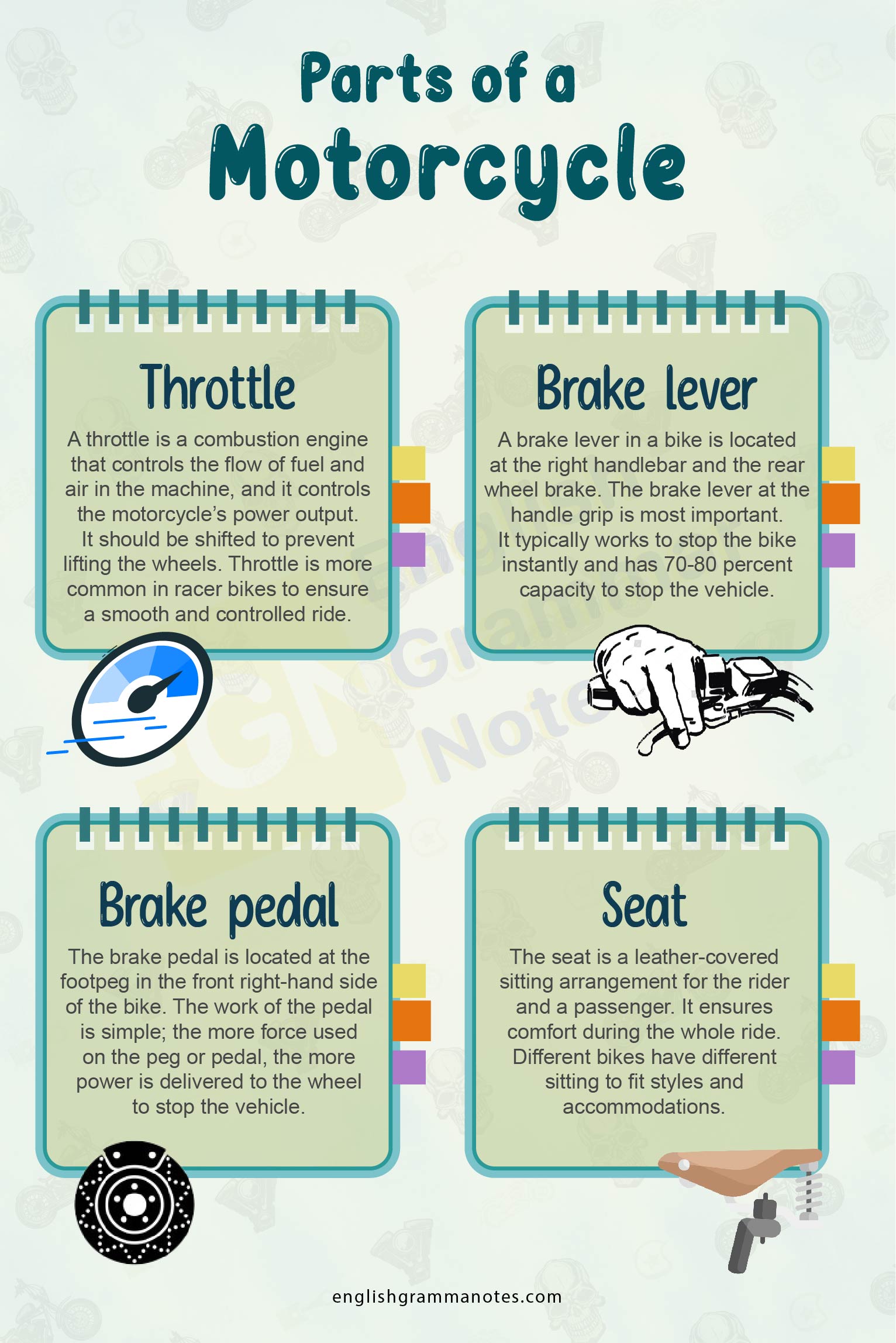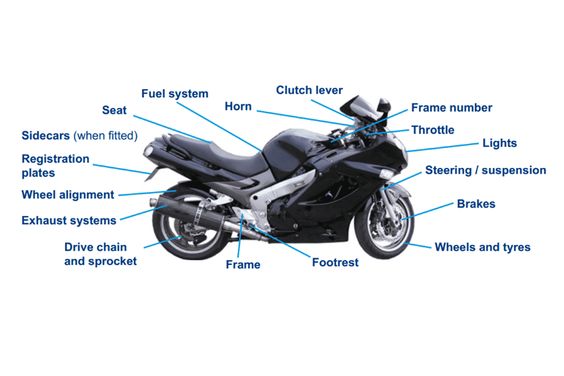Parts of a Motorcycle Vocabulary: Do you want to buy a motorcycle for yourself? First, you should know the parts of a motorcycle and their function to get the best guide for yourself. A motorcycle is a very accessible vehicle-like car that offers various options and models to choose from. You can easily change Parts of it also, but some basic parts of the motorcycle are common for all.
To help you have a wonderful experience with your bike ride, we have a list of parts of a motorcycle vocabulary that will help you get hold of the best model with the best features.
Study the most important English Vocabulary Words identified by our experts and learn the right vocabulary to use in your day to day conversations
List of Parts of a Motorcycle Vocabulary Words in English
- Names of outdoor activities vocabulary words
- Description of the outdoor activities Vocabulary words.
Names of Parts of a Motorcycle vocabulary Words
In the English language, a broad range of words to know about motorbikes. Therefore, the vocabulary words for motorcycle part name are many and has exciting features. First, however, bikers should know the basic parts not to get fooled on roads.Let’s have a look at the list below to get hold of all the names. This article will assist you in ensuring your best ride.
List of Parts Of A Motorcycle
- Throttle
- Brake lever
- Helmet
- Seat
- Engine
- Tire
- Brake pedal
- Gear shifter
- Pegs
- Fuel tank
- Headlight
- Hazard flasher light
- Warning light
- Engine switch
- Start button
- Mudguard
- Kickstand
- Storage
- Exhaust system
- Suspension
- Carburetor
- Handlebars
- Battery
Description of the Parts of a Motorcycle Vocabulary Words
Throttle
A throttle is a combustion engine that controls the flow of fuel and air in the machine, and it controls the motorcycle’s power output. It should be shifted to prevent lifting the wheels. Throttle is more common in racer bikes to ensure a smooth and controlled ride.
Brake lever
A brake lever in a bike is located at the right handlebar and the rear wheel brake. The brake lever at the handle grip is most important. It typically works to stop the bike instantly and has 70-80 percent capacity to stop the vehicle.
Helmet
A helmet of a motorcycle is designed to ensure the safety of the biker and their passenger. The helmet is the only element to protect a biker from any injuries by covering their head. Therefore, buying a helmet from a bike company is advised rather than purchasing it from a local store for less money.
Seat
The seat is a leather-covered sitting arrangement for the rider and a passenger. It ensures comfort during the whole ride. Different bikes have different sitting to fit styles and accommodations.

Engine
The engine is the powerhouse for motorcycles consisting of pistons, cylinder block, and head, which helps transfer energy from pistons into rotary motion. The engines can be two or four-stroke combustion style and three types: V-twin, inline two-cylinder, or four-cylinder. V-twin is common in Japanese cruisers and Harley Davidson, parallel two-cylinder in touring bikes, and inline four-cylinder in European bikes.
Tire
Tires of motorcycles are available in different sizes and shapes depending on the model, type of ride you want, and how you want to style the bike. Off-road tires are meant to have grip in sand and mountain to maintain traction. Street tires have maximum surface area coverage to give smooth riding, and dual-sport tires are suitable for street and off-road tires.
Brake pedal
The brake pedal is located at the footpeg in the front right-hand side of the bike. The work of the pedal is simple; the more force used on the peg or pedal, the more power is delivered to the wheel to stop the vehicle.
Gear shifter
The gear shifter is located at the left footpeg of the motorcycle, and it changes the transmission gear up-down. Gear shifters are not present in all types, like a few automatic motorcycles and scooters, usually because they have buttons or paddles for the work.

Pegs
Footpegs work as foot holders and help to keep feet in control during rides. Footpegs are foldable and are also for passenger use, and it includes passenger, engine guard, highway, and anti-vibration.
Fuel tank
The fuel tank in a bike is located just above the engine, and its prime function is to store a good quantity of fuel based on the capacity of the motorcycle. It is filled from outside via a small hole that is sealed when not in use.
Headlight
Headlights are the most important to make yourself visible to other drivers on the road, especially at night. To increase the visibility of the headlight, consider installing halogen or led bulbs and improve the quality of the ride.
Hazard flasher light
Hazard lights are installed at the sides with other lights on a bike. Hazard flasher light increases visibility on-road on the road and provides a blinking facility to indicator lights. Motorcycles should have at least one safety light to ensure safety.
Warning light
Warning lights are located at the dashboard for the rider’s focus. The type of color it shows represents the seriousness of the warning. Green or blue light indicates that the system is working properly, amber indicates that the system has some fault and should be taken care of immediately. The red light says that you must stop the engine to lessen the chances of further accidents.
Engine switch
The engine switch helps a biker in traffic save fuel by repeatedly turning the switching ignition key to close and open. It is located close to the throttle in red color and can be handled manually.
Start button
A start button only requires the rider to press the button to start the ride using the kickstand. Thus, it is easier to use and installed on the machine.
Mudguard
Mudguards in motorcycles are fixed at the top or over the front tires. A motorcycle’s prime function is to protect the bike from mud and water caused by the ride and not enter the system.
Kickstand
The basic function of a kickstand is to hold the bike upright when you are not riding it. There are two types of stand; the side stand is fitted in all bikes at the left-hand side under the footpeg. Center stand is not available in all motorcycles, takes the weight of the full bike straight up, and maintains storage.
Storage
Most motorcycles have a storage accommodation to store the helmet or other necessities. However, only superbikes or sportbikes may not have access to any storage place for their off-road use.
Exhaust system
The exhaust system in motorcycles removes harmful gases away from the rider and vehicle. Removing harmful combustion gases enhances the performance of the machine. Bikers may choose to use futuristic bikes which produce less sound than feral ones.
Suspension
A suspension in front and rear protect the biker and passenger from any road disturbance like bumps and vibrations. Two parts compose suspension; the spring and damper. The spring supports the passenger’s weight and prevents disturbances, and the damper creates gravity to prevent the passenger from tripping over.
Carburetor
A carburetor’s job in a motorcycle is to supply an internal combustion engine with air and fuel. It contains valves, chambers, and tubes which can blend air and fuel. Recent bike EFI in place of the carburetor and makes it easily accessible.
Handlebars
Handlebars work like a steering control for the motorcycles to assist the rider in giving balance and control of the ride. It is advised to use rubber grips in handles to prevent fingers from slipping and maintaining grip.
Battery
The Batteries in the motorcycles are small in size and are designed to make them run smooth on the road. It stores electric energy generated by reversible chemical reactions in lead and acid.
